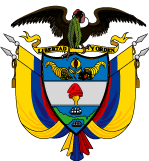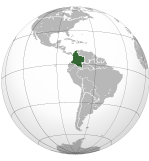Networked Society
To what extent are individuals using information and communication technologies at work and in their personal lives? Are there significant opportunities available for those with ICT skills?

10. People and Organizations Online (Stage 3)
Slightly less than half the Colombian population uses the Internet in any capacity, whether it is for work, school, or home use. The demographic group most likely to use the Internet is those aged 25 to 55 years old. This would seem to indicate that those most likely to be currently in the workforce have at least some use for the Internet. However, more Colombians still use the Internet at home or in Internet cafes than at work.
Colombians use the Internet mostly to get information or to communicate with one another. The activity of least use is e-commerce, followed closely by use for governmental purposes. Other major categories of use would be for entertainment such as music downloads and online gaming, as well as use in education. In a recent visit to Colombia it was observed that social media has begun to take hold. Social media sites such as Facebook and Twitter are becoming popular in the 25 to 55 year old age group. While as few as two years ago most people were not using the Internet in any capacity, this recent observation may indicate that the technology adoption rate is increasing rapidly.
Gender/ Age Range |
Total number of persons |
Used Internet |
Did Not use Internet |
|
5 years old and over |
in last 12 mo |
in last 12 mo |
||
TOTAL |
20,104,068 |
7,548,288 |
12,555,781 |
|
|
5 to 11 |
2,713,708 |
723,422 |
1,990,286 |
12 to 17 |
2,404,118 |
1,715,718 |
688,400 |
|
18 to 24 |
2,768,660 |
1,736,384 |
1,032,276 |
|
25 to 55 |
9,408,352 |
3,134,899 |
6,273,453 |
|
56 and over |
2,809,232 |
237,865 |
2,571,367 |
|
Men |
Sub total |
9,565,823 |
3,766,321 |
5,799,502 |
5 to 11 |
1,364,908 |
376,852 |
988,056 |
|
12 to 17 |
1,256,963 |
869,580 |
387,383 |
|
18 to 24 |
1,340,951 |
850,382 |
490,569 |
|
25 to 55 |
4,380,839 |
1,530,205 |
2,850,634 |
|
56 and over |
1,222,162 |
139,303 |
1,082,859 |
|
Women |
Sub total |
10,538,245 |
3,781,966 |
6,756,279 |
5 to 11 |
1,348,799 |
346,570 |
1,002,229 |
|
12 to 17 |
1,147,155 |
846,138 |
301,017 |
|
18 to 24 |
1,427,708 |
886,002 |
541,707 |
|
25 to 55 |
5,027,513 |
1,604,694 |
3,422,819 |
|
56 and over |
1,587,070 |
98,563 |
1,488,507 |
|
Major Cities |
# of people who used Internet |
At Home |
At Work |
At School |
Location of free public access |
Location with public access with charge |
A Neighbor or Friend’s Home |
||||||
(Internet Cafe) |
|||||||||||||
Si |
No |
Si |
No |
Si |
No |
Si |
No |
Si |
No |
Si |
No |
||
TOTAL 24 Cities |
7,548,288 |
3,309,888 |
4,238,399 |
1,855,156 |
5,693,132 |
2,010,447 |
5,537,840 |
310,700 |
7,237,587 |
3,560,649 |
3,987,639 |
1,226,602 |
6,321,686 |
MEDELLIN A.M. |
1,151,379 |
584,325 |
567,054 |
320,012 |
831,367 |
389,138 |
762,242 |
101,912 |
1,049,467 |
351,830 |
799,549 |
214,831 |
936,548 |
BARRANQUILLA A.M. |
350,330 |
155,443 |
194,887 |
99,251 |
251,079 |
111,837 |
238,493 |
4,445 |
345,885 |
142,851 |
207,479 |
32,354 |
317,976 |
BOGOTA |
3,085,896 |
1,475,608 |
1,610,288 |
805,638 |
2,280,258 |
757,180 |
2,328,716 |
95,426 |
2,990,470 |
1,450,890 |
1,635,006 |
504,467 |
2,581,429 |
CARTAGENA |
194,810 |
74,182 |
120,628 |
40,018 |
154,793 |
49,662 |
145,148 |
2,085 |
192,726 |
99,906 |
94,904 |
17,955 |
176,856 |
TUNJA |
56,588 |
13,020 |
43,569 |
12,683 |
43,905 |
17,873 |
38,715 |
560 |
56,029 |
35,713 |
20,875 |
3,658 |
52,930 |
MANIZALES A.M. |
135,733 |
59,323 |
76,410 |
30,477 |
105,256 |
46,881 |
88,852 |
4,119 |
131,614 |
56,566 |
79,167 |
29,806 |
105,927 |
FLORENCIA |
31,766 |
8,739 |
23,027 |
7,444 |
24,322 |
9,063 |
22,703 |
1,009 |
30,757 |
20,193 |
11,573 |
4,377 |
27,389 |
POPAYAN |
65,670 |
16,190 |
49,480 |
9,053 |
56,617 |
8,736 |
56,934 |
1,161 |
64,509 |
41,495 |
24,175 |
1,332 |
64,338 |
VALLEDUPAR |
87,562 |
27,063 |
60,499 |
14,405 |
73,157 |
33,528 |
54,034 |
3,464 |
84,099 |
51,758 |
35,804 |
11,850 |
75,713 |
MONTERIA |
81,010 |
22,733 |
58,277 |
16,998 |
64,013 |
17,883 |
63,128 |
387 |
80,623 |
47,505 |
33,506 |
7,924 |
73,086 |
QUIBDO |
12,101 |
3,756 |
8,345 |
2,604 |
9,496 |
2,807 |
9,294 |
879 |
11,221 |
7,320 |
4,781 |
2,626 |
9,475 |
NEIVA |
109,803 |
39,512 |
70,292 |
22,550 |
87,253 |
22,071 |
87,732 |
2,640 |
107,163 |
62,250 |
47,553 |
23,094 |
86,709 |
RIOACHA |
34,343 |
8,053 |
26,290 |
6,263 |
28,081 |
12,059 |
22,285 |
781 |
33,563 |
20,169 |
14,174 |
3,302 |
31,041 |
SANTA MARTA |
118,245 |
33,119 |
85,126 |
17,441 |
100,804 |
23,202 |
95,044 |
6,680 |
111,566 |
74,640 |
43,605 |
21,386 |
96,859 |
VILLAVICENCIO |
135,707 |
42,584 |
93,123 |
25,296 |
110,411 |
11,606 |
124,101 |
1,706 |
134,001 |
76,811 |
58,895 |
9,193 |
126,513 |
PASTO |
117,352 |
37,923 |
79,428 |
26,755 |
90,597 |
44,672 |
72,680 |
1,862 |
115,490 |
67,109 |
50,243 |
18,262 |
99,090 |
CUCUTA A.M. |
193,575 |
60,783 |
132,792 |
31,721 |
161,855 |
36,950 |
156,625 |
5,425 |
188,150 |
115,993 |
77,583 |
23,361 |
170,214 |
ARMENIA |
92,013 |
36,851 |
55,162 |
19,412 |
72,601 |
25,810 |
66,203 |
1,684 |
90,329 |
49,949 |
42,064 |
18,848 |
73,165 |
PEREIRA A.M. |
221,096 |
97,525 |
123,571 |
45,812 |
175,283 |
66,160 |
154,935 |
4,422 |
216,674 |
108,801 |
112,294 |
47,428 |
173,667 |
BUCARAMANGA A.M. |
329,912 |
158,957 |
170,955 |
68,664 |
261,247 |
83,669 |
246,243 |
5,292 |
324,620 |
147,267 |
182,645 |
37,039 |
292,873 |
SINCELEJO |
52,952 |
12,622 |
40,330 |
9,020 |
43,932 |
17,065 |
35,886 |
360 |
52,592 |
32,516 |
20,436 |
3,855 |
49,097 |
IBAGUE |
161,935 |
53,652 |
108,284 |
32,050 |
129,886 |
43,072 |
118,863 |
3,470 |
158,465 |
103,975 |
57,961 |
31,832 |
130,103 |
CALI A.M. |
718,619 |
285,595 |
433,024 |
188,246 |
530,374 |
176,396 |
542,223 |
59,210 |
659,409 |
389,283 |
329,337 |
156,798 |
561,821 |
SAN ANDRES |
9,889 |
2,333 |
7,557 |
3,342 |
6,547 |
3,126 |
6,763 |
1,722 |
8,168 |
5,860 |
4,029 |
1,024 |
8,865 |
We rate Colombia’s online presence for people and organizations as Stage 3. Slightly less than half of the country’s citizens are regular Internet users, though this number is increasing rapidly.
11. Locally Relevant Content (Stage 3)
Language is a consideration for any foreign company considering an investment in Colombia. The primary language spoken is Spanish, with only 7 percent of the population being bilingual (English/Spanish). Software intended for domestic use must contain Spanish language capabilities. The key challenge to domestic Colombian providers is to offer current and relevant information in a format that is accessible by its audience.
Current services provided to the citizens are:
- General municipal information
- An electronic system for viewing public contracts and responding to government tenders
- Public institution information and services for the general public, private companies and civil servants
- Virtual libraries and museums
- Cultural events such as carnivals, fairs, and other celebrations
Recently, government agencies in Colombia established websites filled with information relevant to citizens and potential investors alike. An organization dedicated to educating and assisting foreign technology investors, Proexport, and its English language version, www.investincolombia.com was recently established by the Colombian government.
We rate Colombia’s locally relevant content as Stage 3. There are multiple resources available to both citizens and interested foreign parties alike. The availability of English-language local information is still somewhat limited, which could prove to be a barrier to western foreign investment.
12. Information & Communication Technologies in Everyday Life (Stage 2)
Most urban Colombians prefer more traditional media, such as newspapers, radio, and television. There are approximately 1,600 radio stations throughout Colombia. The government is working on control standards to guarantee the relevance and quality of the contents these stations produce.
Although most Colombian municipalities have web sites, most of the government websites as well as the educational portals do not compile any data regarding the users of the site. The government is working through the process of setting up quality control methods and enhancing the delivery of information to the public sector.
We rate Colombia’s ICT in everyday life as Stage 2. The majority of the Colombian population does not rely on technical means to support their daily activities. The adoption of technology is expanding rapidly, driven by government initiatives and foreign investment in technology centers.
13. Information & Communication Technologies in the Workplace (Stage 3)
Computers and phones are generally available in the workplace to conduct business. According to 2005 census data about 20% of people used a computer to complete their work, less than those simply using it at home for personal purposes.
Technology use in business has grown recently. Credit card usage has increased, requiring networks to become more robust. Networks for point of sale systems have been established in many retail outlets. Sophisticated wireless networks are being established to handle the increased demand by business owners to be connected. There has also been an increase in the establishment of networks across branches of retail establishments. Banks and utilities pioneered their use and the technology is trickling down to smaller businesses as price points come down and technology becomes more readily available.
We rate Colombia’s ICTs in the workplace a Stage 3. Though networks and technology-based transactions are becoming more commonplace, technology usage in business is not yet widespread. The bulk of Internet usage is for personal and recreational purposes. Major advances in efficiency and productivity through the implementation of technological solutions have not yet been realized, though major strides are being made in this direction.
 Colombia’s Networked Readiness
Colombia’s Networked Readiness